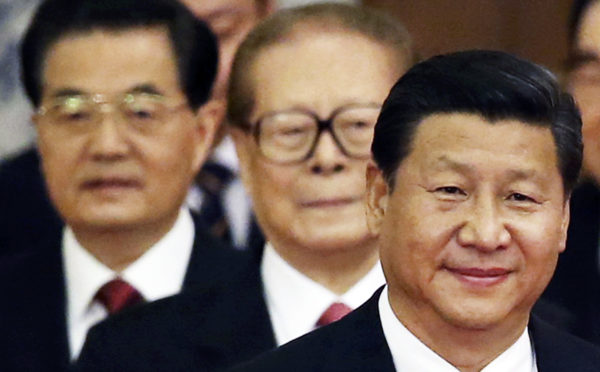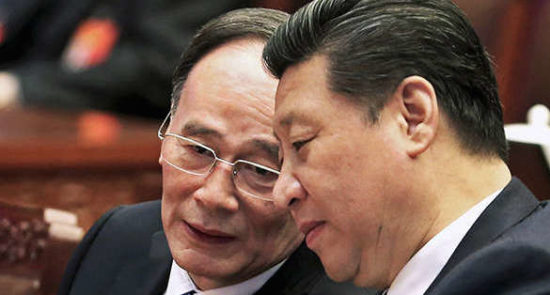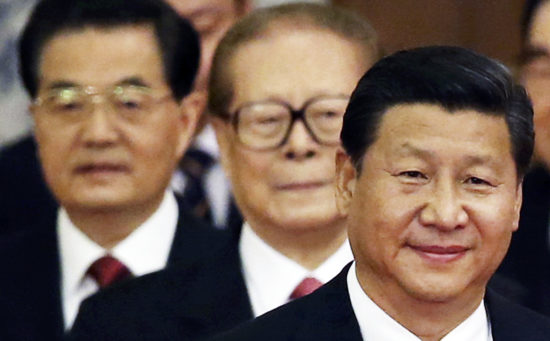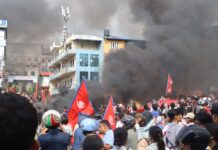A new stage in the CCP’s internal power struggle unfolds
chinaworker.info reporters
Xi Jinping has been proclaimed the “core” of China’s ruling dictatorship. The decision, taken at the sixth plenum of the CCP (Chinese Communist Party) Central Committee in October, along with the approval of two documents imposing stricter controls over senior officials, raises many questions about the power struggle within the ruling elite, and especially about next year’s leadership makeover.
The concept of “core leader” originated with Deng Xiaoping, who used it in the early 1990s to describe Jiang Zemin as a way to bolster Jiang’s authority at a time of great uncertainty and instability within the regime following the 1989 Beijing massacre. With Xi acquiring this mantle, a People’s Daily editorial declared, “The party centre and the whole party must have a core.” There is a “dire need for strong leadership” said a headline in the ultra-nationalist Global Times, another CCP organ, quoting an ‘expert’ from the Research Centre for Government Integrity Building.
Since he took the helm in late 2012, Xi has purged a number of top officials and used his anti-corruption campaign to attack other factions and consolidate his own power. The ferocity and scale of this shake-up has led Xi to be regarded as the ‘most powerful’ leader since Mao Zedong. The CCP-state is a vastly different animal today compared to those times. Xi heads a dictatorship that acts on behalf of China’s billionaire elite, whose wealth has grown enormously in recent years as has its appetite for power. As of October 2016, there are 594 billionaires in China, more than the 535 billionaires in the US. Most of China’s new oligarchy have emerged from or are beholden to the CCP-state.
Xi has concentrated much greater power in his own hands than his immediate predecessors, sidelining the former collective leadership model – fraudulently described as ‘democratic centralism’ by the CCP and its media. That model was adopted after Mao’s death to insert some ‘checks and balances’ into the structures of the authoritarian state and prevent the rise of a new ‘strong man’. The top levels of the dictatorship, especially the pivotal Politburo Standing Committee, became power-sharing forums for the representatives of rival factions linked to economic or regional ‘fiefdoms’.
‘Bold surgery’
Xi’s abandonment of this model signified the onset of a deep crisis in the regime, whereby ‘bold surgery’ was deemed to be necessary to try to overcome a paralysis of policy-making (many policies but little effect) and especially the tendency of the regions and lower-levels of the state to evade or merely pay lip service to the commands of the centre.
“Many of the party’s policies can’t get implemented. Some people even run independent kingdoms in their own units, departments and localities,” says Deng Maosheng, a top official at the party’s Central Policy Research Office. “The higher-ups have policy measures, but those below have countermeasures.”
This issue – the inability of the centre to control the regions – plagues every area of Chinese policy from the alarming debt build-up and monster levels of overcapacity in the economy to military policy. It also explains the severity of Xi’s crackdown on dissent – against lawyers, journalists and striking workers. This is “the most aggressive campaign against human rights since the 1989 Tiananmen Massacre,” says US-based Human Rights Watch.
As chinaworker.info has explained before, Xi’s push to recentralise power is not just a personality quirk (which may be an additional factor) but flows from a sense of crisis – that without this CCP rule is threatened with collapse.
Prior to the sixth plenum meeting, Xi had already amassed an impressive array of official posts. He is “Chairman of everything”, controlling policy in no fewer than twelve departments ranging from the economy, the military, internal security, cybersecurity and information technology. How does the designation “core leader” add to this collection?
If anything it suggests that after four years, the fiercest power struggle since 1989 has still not handed a decisive victory to Xi. “Xi has encountered obstacles; if there were no obstacles, there would be no need for a core leader,” argues Robert Lawrence Kuhn, a pro-CCP American businessman writing in the South China Morning Post. Zhou Xiaosheng of Renmin University agrees: “It is obvious that all this noise about loyalty is because there is a lack of loyalty.”

19th Congress
Therefore, Xi’s elevation to “core leader” does not suggest a decisive victory, but rather that he and his coterie are preparing to escalate the internal power struggle as next year’s CCP Congress approaches.
At the 19th CCP Congress, to be held at the end of 2017, a total of 13 of the current 25-member Politburo must stand down on the grounds of age, including five of the seven Standing Committee members. This, if previous norms are followed, would mean only Xi Jinping and current premier, Li Keqiang, would keep their places in the Standing Committee, which is the apex of power in the CCP-state system. There has been much speculation that Xi intends to depart from the unwritten qishang baxia (seven up, eight down) convention, whereby an official aged 67 can seek a new term of office, but must step down if they’ve reached the age of 68.
The focus of much speculation is the position of Wang Qishan, a fellow princeling (‘red aristocracy’ – heir to a top CCP family) like Xi, and the president’s key ally in the Standing Committee. It is Wang who has masterminded Xi’s ‘shock and awe’ anti-corruption campaign, which in reality is a weapon of central control to attack factional opponents, instil a degree of terror within the state apparatus, and bring regional governments into line. Wang’s Central Commission for Discipline Inspection (CCDI) has expanded over the past four years, extending into all sectors of government as the key ‘enforcer’ of Xi’s rule. It recently reprimanded the Central Propaganda Department for not imposing Xi’s line rigorously enough upon the media.
It seems Xi wants at all costs to keep Wang by his side, although that will mean waiving the age guidelines (Wang will be 68 next year). Significantly, Deng Maosheng, who helped draft the documents for the sixth plenum meeting, told a press conference, “The strict boundaries of the ‘seven up, eight down’ don’t exist”. These comments have further fuelled speculation that change is afoot.
It is even rumoured that Wang is being lined up to replace Li as premier, in charge of economic policy, after the congress. Li has already been largely sidelined within the leadership, and could be moved on to a more ceremonial post such as chair of the rubber-stamp National People’s Congress. Wang, known as a ‘reformer’ in economic terms, now has a fearsome reputation from his time as ‘anti-corruption czar’ and may be seen as a tougher proposition as premier, in forcing recalcitrant local governments to toe the line. Wang was mentored by Zhu Rongji, who as premier presided over a brutal shake-up of the Chinese economy in the late 1990s, steering the country into the WTO by slashing 40 million state sector jobs and privatising the housing market.
It seems that the measures adopted at the sixth plenum meeting, including designating Xi as “core leader”, are designed to strengthen his hand in forcing through his own leadership selection, favouring Xi loyalists at the expense of rival factions. This process has already begun with a shake up of provincial government bosses, including a number of appointees regarded as close to Xi and Wang.
Whereas in the first years of Xi’s rule he purged ‘tigers’ (top officials) linked to Jiang Zemin’s faction, in the past year it is the tuan pai (Communist Youth League) faction that has borne the brunt of the factional bombardment. In May, the League had its budget halved, forcing it to shed personnel. It was criticised as “inefficient and elitist” by state media. Premier Li is the most prominent representative of this faction and it seems likely he and other tuan pai affiliates will be the biggest losers when the new leadership is unveiled in a year’s time.
Following Putin?
Most speculation centres on reports that Xi plans to extend his own rule, in one form or another, beyond the two five-year terms laid down in the rulebook. Emulating his role model Vladimir Putin of Russia, Xi may be scheming to stay on after 2022, perhaps relinquishing some of his formal posts, but exercising the real power from behind the throne, much as Putin did when he installed Dmitry Medvedev as “his” president before reclaiming the post himself. In China, the post of president is limited to two terms, but there is no such cap on the post of CCP General Secretary, also held by Xi, which is the more powerful of the two positions. In this context, keeping Wang Qishan in the Standing Committee at next year’s congress may also serve as a test case for abandoning the old rules and restraints, opening the way for Xi to install himself for a third term or longer.
Both Jiang Zemin, who retired in 2002, and Hu Jintao, who retired in 2012, were succeeded at the top by a representative from another faction. This too was part of the system of ‘checks and balances’ built into the CCP’s internal machinery to prevent any individual acquiring too much power. Xi’s project, to dismantle these safeguards, risks blowing up the very edifice he wants to save.
The era of Xi Jinping, as we have explained before, signals the onset of an unprecedented crisis within the Chinese state. There is a desperation and urgency in Xi’s methods, borne of a sense of grave danger facing the regime. He is “taking his country in radical and risky new directions” according to Gideon Rachman in the Financial Times. Xi’s centralisation of power and increased repression aims to prevent explosions – mass revolts or systemic economic threats – but his ‘solution’, as other historical examples show, may itself become the trigger for revolutionary upheavals.





